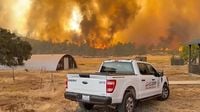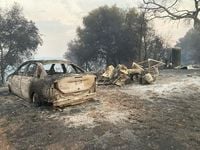On the morning of September 2, 2025, the tranquil landscape of Chinese Camp, California—a town steeped in Gold Rush history—was shattered by the roar of flames and the urgent wail of evacuation sirens. What started as a cluster of lightning strikes in the Sierra Nevada foothills quickly erupted into a ferocious wildfire, forcing residents to flee and threatening to erase a living piece of California’s past.
According to CAL FIRE, the 6-5 Wildfire ignited in Tuolumne County and, by the evening of September 3, had merged with other blazes to form the TCU September Lightning Complex, burning across Tuolumne and Calaveras counties. The numbers were staggering: more than 13,300 acres scorched, more than 40 sheriff’s deputies mobilized, and over 300 residents ordered to evacuate with another 1,400 on high alert. The fire was 0% contained, and the situation remained volatile as strong winds and dry, tall grass fueled the rapid advance of the flames (FOX Weather, FOX40, CAL FIRE).
Chinese Camp, once home to 5,000 Chinese miners during the Gold Rush, now found itself at the epicenter of the disaster. The historic town, a designated landmark nestled about 20 miles northeast of Modesto, has long drawn tourists curious about California’s past. But as the fire raged, video footage from KCRA in Sacramento revealed a heartbreaking scene: several of the town’s old structures reduced to ash and rubble. Resident Salena Moyle, surveying the devastation, summed up the mood in a few words: “There’s really nothing left. Nothing at all.” (KTVU)
The inferno was not an isolated event. CAL FIRE officials reported that the TCU September Lightning Complex consisted of 22 separate fires, all sparked by a barrage of more than 9,000 lightning strikes when thunderstorms swept through the region on September 2 (FOX Weather, AP). Battalion Chief David Acuna put the scale in perspective: “We had over 16,761 lightning strikes between Tuesday and Wednesday. There were lightning strikes deep within tree wells that were just waiting to be found. We’re making sure we extinguish each one of those.” (KTVU)
Firefighters faced a daunting battle. The terrain was rugged and remote, often forcing crews to hike in by foot to reach the flames. “The terrain is challenging to access, requiring fire crews to hike in by foot to many remote locations,” CAL FIRE stated. More than 634 personnel were on the ground, with additional resources arriving as fast as possible (CAL FIRE). Air support was deployed, but strong winds and high temperatures in the 90s complicated efforts, and the threat of undetected fires lingered. “There may be fires that haven’t been identified or discovered yet,” CAL FIRE spokesperson Emily Kilgore warned, emphasizing the unpredictability of the situation (KTVU).
By September 3, the fire had become the third-largest active blaze in California, surpassed only by the Gifford Fire in San Luis Obispo and Santa Barbara counties and the Garnet Fire in Fresno (FOX40). The largest of the TCU complex fires, including the 6-5 fire at Chinese Camp and another near Vallecito, posed immediate threats to homes and communities. Several structures were confirmed destroyed, though a full damage assessment was still pending as of Wednesday evening. The town’s handful of Gold Rush-era buildings—like the 1854 post office and the 1855 Catholic church—were at risk, though some appeared to have survived the flames, at least for now (AP).
For the roughly 100 residents of Chinese Camp, the evacuation was swift and, for many, traumatic. The fire not only threatened their safety but also their connection to a unique heritage. Chinese Camp was originally settled in the 1850s by thousands of Chinese miners who faced intense discrimination, including exorbitant taxes and outright hostility from European miners. Many of the original Chinese-built structures are long gone, but the town has retained some 19th-century buildings from European settlers—a saloon, a boarding house, and a few old homes—testaments to a bygone era (AP).
Stephen Provost, author of “Chinese Camp: The Haunting History of California’s Forgotten Boomtown,” described the town’s allure: “It was like a town that had been trapped in time,” he recalled. Now, he and others anxiously await news of what remains after the fire. “These are places that are personal to our hearts. We got there just in time.” (AP)
Authorities moved quickly to respond. More than 40 members of the Tuolumne County Sheriff’s Office, including deputies from Patrol, the Jail, and Animal Control, were deployed to patrol evacuated areas and assist community members (Tuolumne County Sheriff’s Office). California Governor Gavin Newsom announced that the state had secured a Fire Management Assistance Grant (FMAG) from the Federal Emergency Management Agency (FEMA) to bolster firefighting resources, particularly for the 2-7 fire within the complex that was burning in Calaveras County (FOX Weather). As of Tuesday, over 300 residents had been evacuated and shelters opened to provide refuge.
Evacuation orders were issued for several zones in Tuolumne County, including CCU-133-B, CCU-134, CCU-134-C, CCU-134-D, and CCU-134-E, while warnings extended to surrounding areas due to the potential threat to life and property (FOX40). The fire also closed a highway connecting San Francisco to Yosemite National Park, disrupting travel and tourism in the region (AP).
Despite the scale of destruction, no injuries or loss of life had been reported as of Wednesday evening—a testament to the swift action of first responders and the community’s resilience (KTVU). Still, with the fires active and containment at zero, the danger was far from over. Firefighters remained wary of shifting winds that could reignite embers or spark new blazes, and the ongoing drought conditions meant the threat would likely persist in the days ahead.
For those who stayed behind to defend their homes, the risks were considerable. As Battalion Chief Acuna explained, “For those residents who stay behind to fight the fire themselves, that puts firefighters in a predicament where they have to protect lives first. Property becomes less of a priority in that case.” (KTVU)
As the sun set on September 3, the future of Chinese Camp—and much of the surrounding foothills—remained uncertain. The fire’s full toll on the region’s history and community will only become clear in the days and weeks to come. But for now, the story of Chinese Camp is a stark reminder of both the ferocity of nature and the enduring spirit of those determined to preserve the past, even as the flames threaten to erase it.

